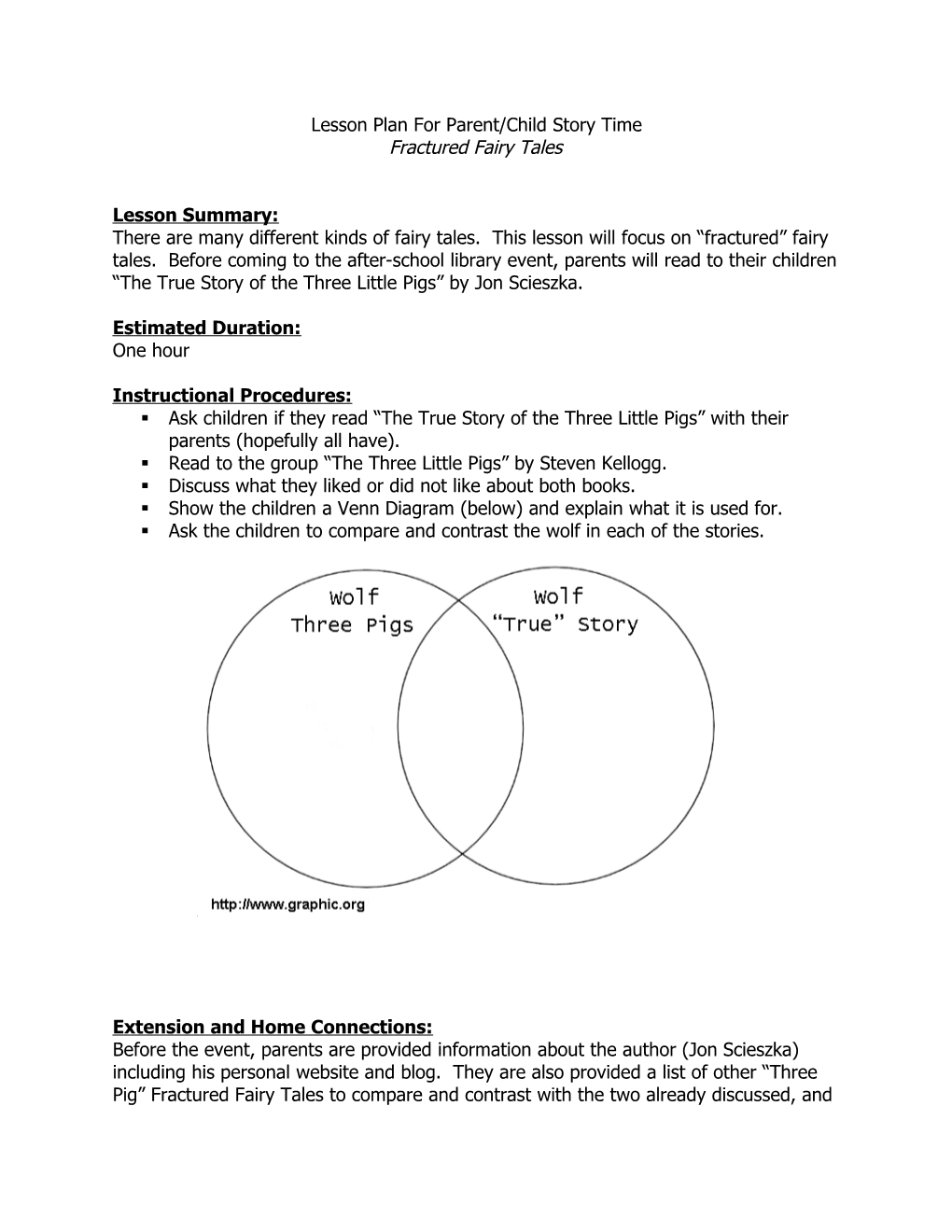Lesson Plan For Parent/Child Story Time
Fractured Fairy Tales
Lesson Summary:
There are many different kinds of fairy tales. This lesson will focus on “fractured” fairy tales. Before coming to the after-school library event, parents will read to their children “The True Story of the Three Little Pigs” by Jon Scieszka.
Estimated Duration:
One hour
Instructional Procedures:
- Ask children if they read “The True Story of the Three Little Pigs” with their parents (hopefully all have).
- Read to the group “The Three Little Pigs” by Steven Kellogg.
- Discuss what they liked or did not like about both books.
- Show the children a Venn Diagram (below) and explain what it is used for.
- Ask the children to compare and contrast the wolf in each of the stories.
Extension and Home Connections:
Before the event, parents are provided information about the author (Jon Scieszka) including his personal website and blog. They are also provided a list of other “Three Pig” Fractured Fairy Tales to compare and contrast with the two already discussed, and a list of other fun Fractured Fairy Tales. Finally, parents will also find on the library website a “Reading and Literacy” page where numerous resources are listed.
Interdisciplinary Connections:
During the event, students will create (with their parent) their own pig house out of various supplies including:
- straws
- wooden popsicle sticks
- toothpicks
- legos
- candy
- raffia
- glue
- markers/crayons
- Styrofoam blocks (packing peanuts)
Participating students will vote for their favorite house. All houses will be displayed in the library for all students to view.
Academic Standards Addressed:
Language Arts:
Comprehension Strategies Grades
Standard Description / 1 / 2 / 3 / 4 / 5Establish a purpose for reading (e.g. to be informed, to follow directions or to be entertained). / X / X / X
Visualize the information in texts and demonstrate this by drawing pictures, discussing images in texts or writing simple descriptions. / X
Make predictions while reading and support predictions with information from the text or prior experience. / X / X / X
Compare information (e.g., recognize similarities) in texts with prior knowledge and experience. / X / X / X / X / X
Recall the important ideas in fictional and non-fictional texts. / X
Create and use graphic organizers such as Venn diagrams or webs, with teacher assistance, to demonstrate comprehension. / X / X / X / X / X
Language Arts: Grade 1
Self-Monitoring Strategies
- Monitor comprehension of independently – or group-read texts by asking and answering questions.
Fine Arts: Creative Expression and Communication: Grades K-4
Benchmark A:Demonstrate knowledge of visual art materials, tools, techniques and processes by using them expressively and skillfully.
Benchmark C:Develop and select a range of subject matter and ideas to communicate meaning in two and three-dimensional works of art.
Fine Arts: Creative Expression and Communication: Grades 5-8
Benchmark A:Apply knowledge of materials, tools, media, techniques and processes to communicate subject matter, themes or ideas in a variety of visual forms.
Fine Arts: Analyzing & Responding: Grades K-4
Benchmark C:Contribute to the development of criteria for discussing and judging works of art.
American Association of School Librarians (AASL) Standards for the 21st-Century Learner
4. Pursue personal and aesthetic growth
4.1 Skills
4.1.1Read, view, and listen for pleasure and personal growth.
4.1.2Respond to literature and creative expressions of ideas in various formats and genres.
4.1.8Use creative and artistic formats to express personal learning.
